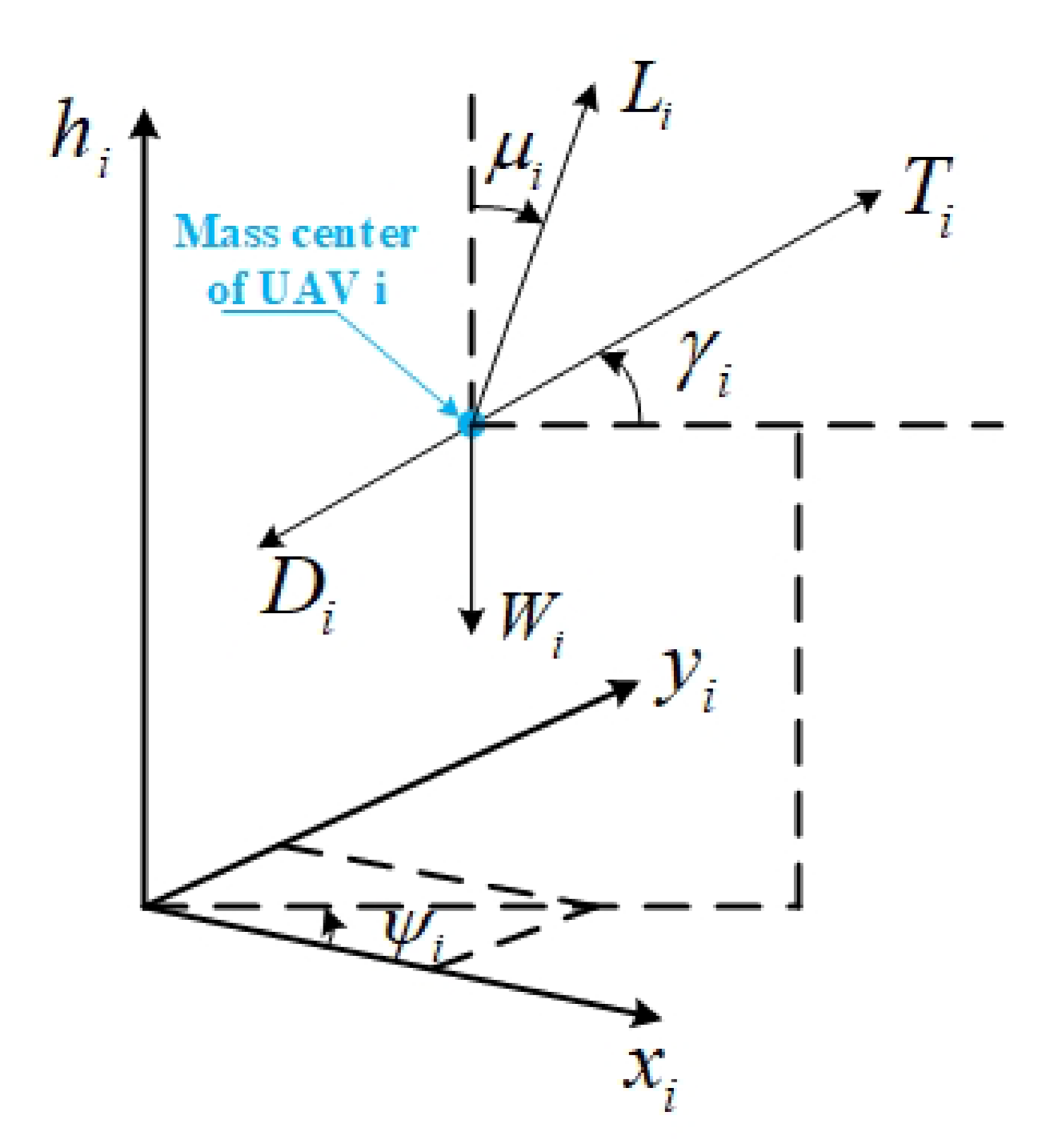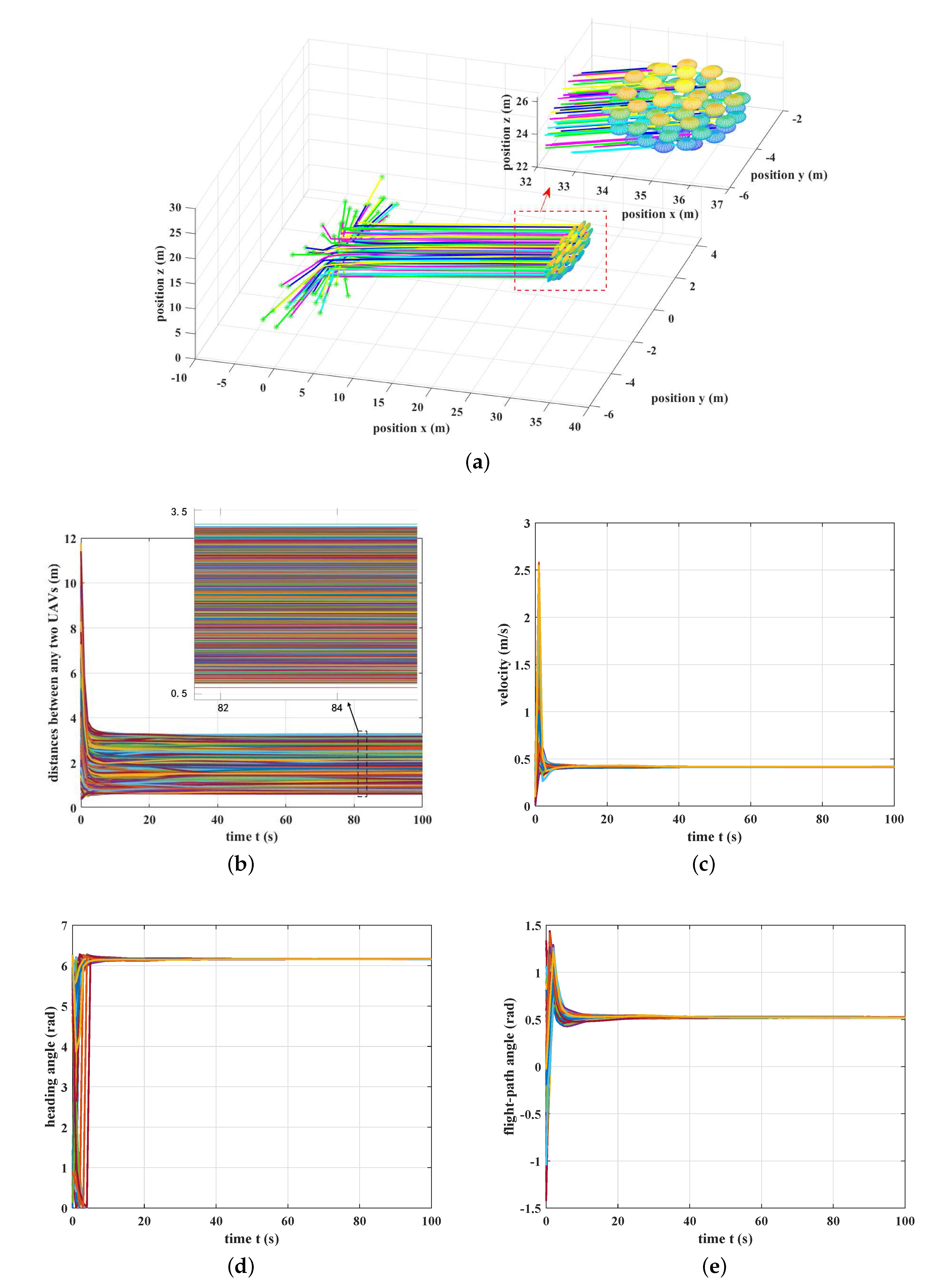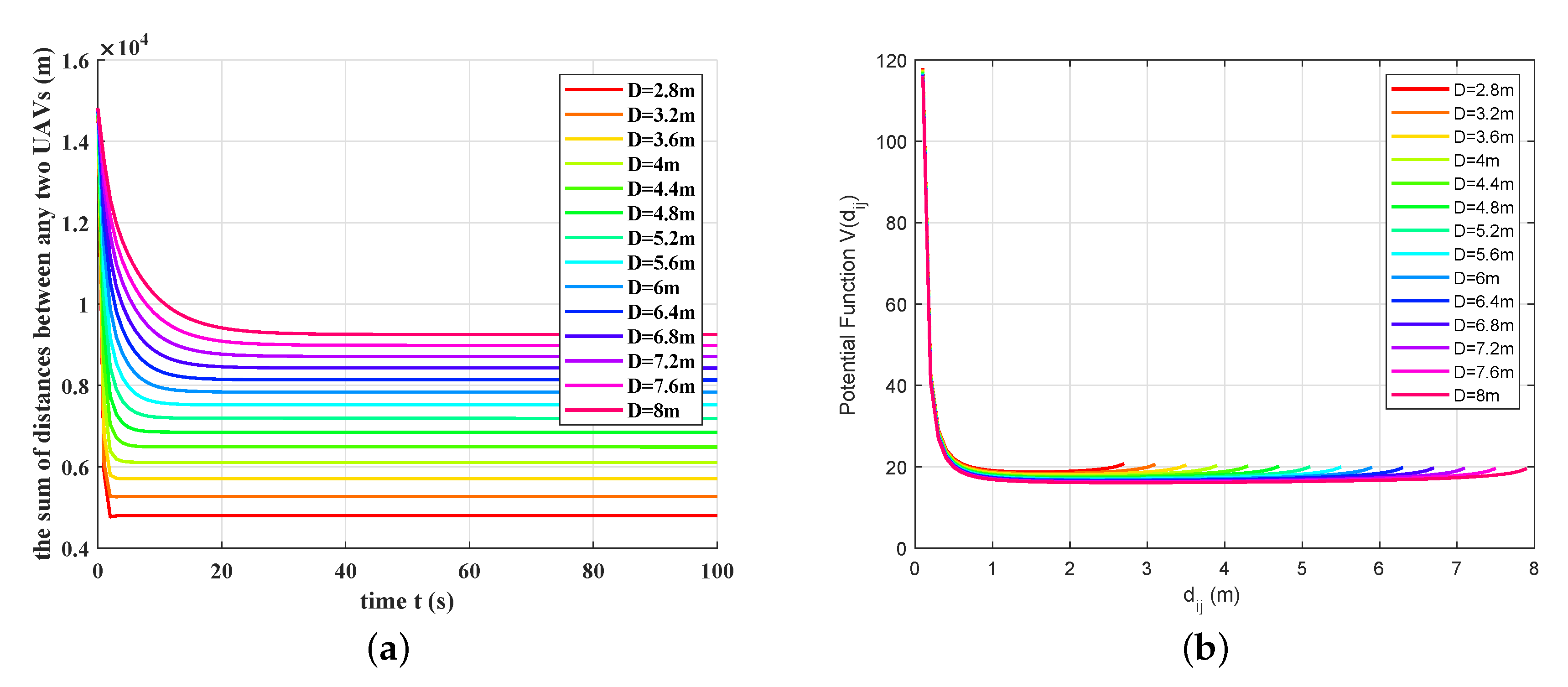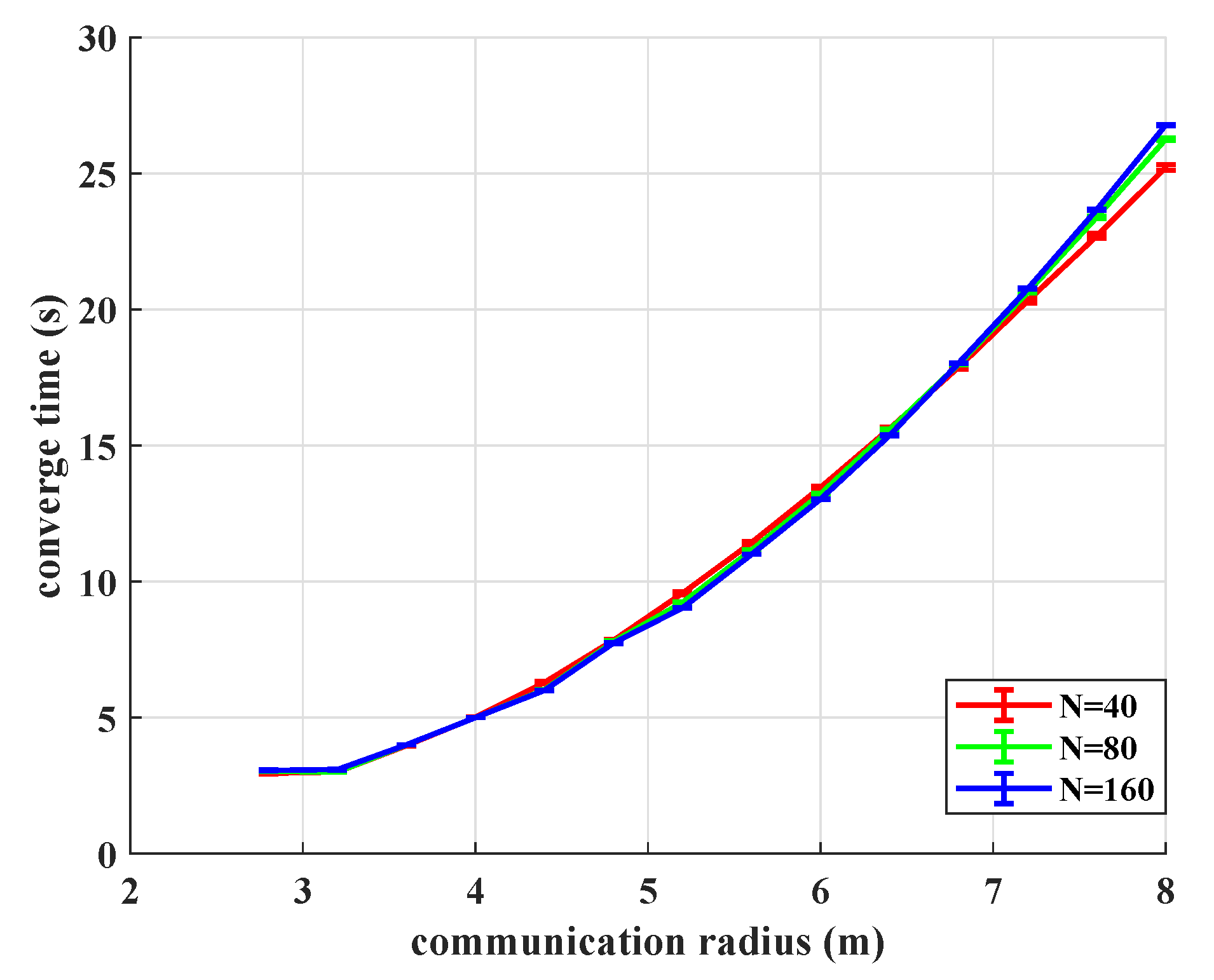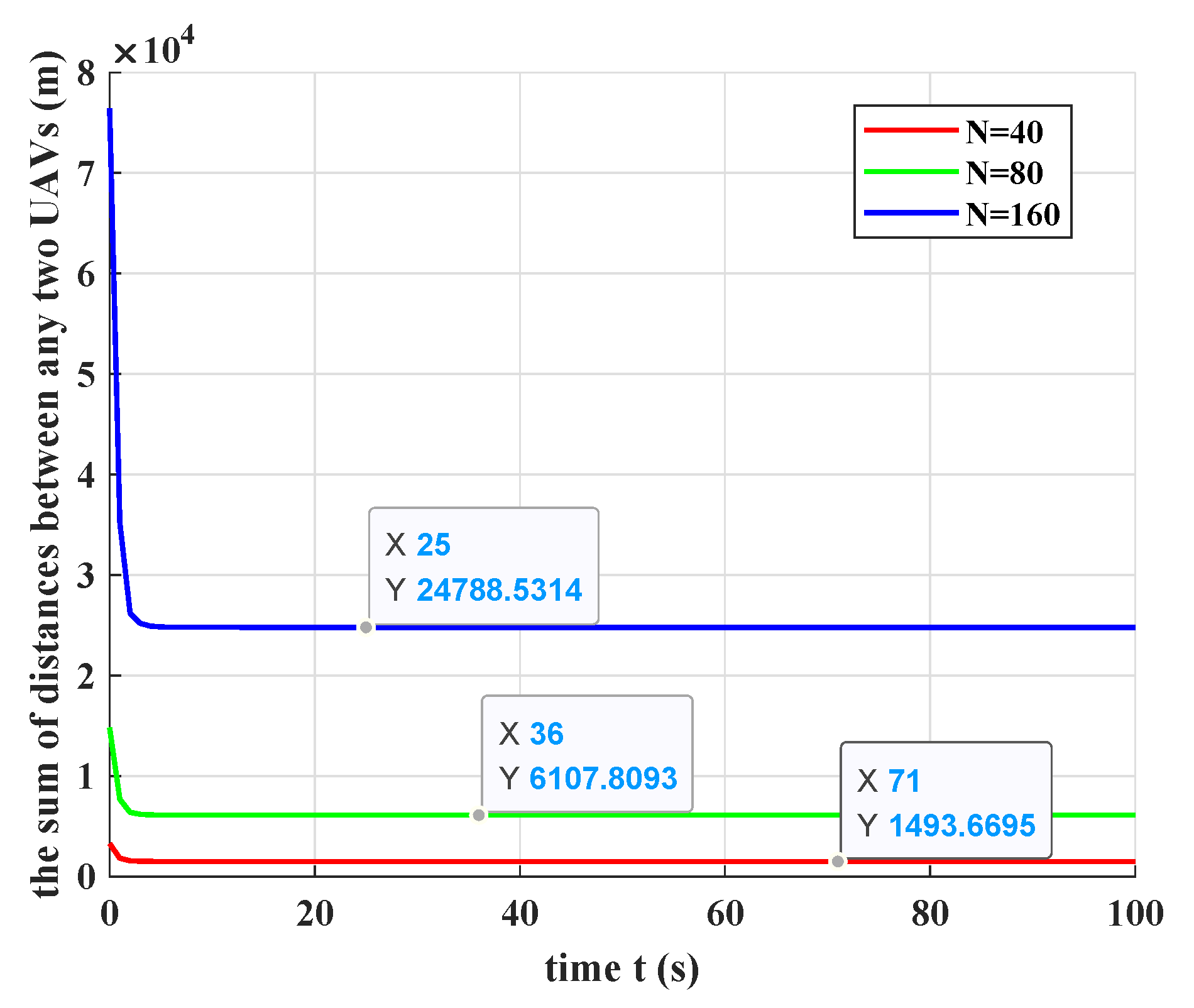1. Introduction
Aerial swarm has been considered as one of the most challenging, exciting, and multidisciplinary fields of robotics in the last decades [
1,
2,
3,
4,
5,
6,
7,
8,
9]. Compared with single-robot systems, aerial swarm systems are expected to be more robust to failure and own faster response capability to complete complex tasks, such as patrolling, exploration, and search and rescue in large areas. Flocking is a type of collective behavior emerging from a set of individuals that rely only on simple rules and local sensing. In recent years, flocking has been widely studied as an effective and low-cost solution to aerial swarm. However, the computation complexity and quantity will increase sharply following the expansion of the scale of the group. Therefore, it is necessary to discuss how to accelerate the emergence of flocking structures.
The literature on flocking can be summarized into two categories. One category is to discuss the flocking problem by using rigorous mathematical analysis [
10,
11,
12,
13,
14]. There are mainly three basic elements to study the flocking behavior in this category, including model, interaction rules, and distributed control protocol. Prior studies on flocking are mainly based on either the simple first-order or second-order integrator model or a general dynamic model [
15,
16,
17]. The nonlinear dynamics inherent in the system of Unmanned Aerial Vehicles (UAVs) remain sparse, which can, with a large probability, cause the failure of the proposed control algorithm to resolve the coordination control of UAVs. A kind of scale-dependent interaction rule is usually adopted, called the nearest-neighbor interaction rule [
18]. The mechanism of the interaction network depends on communication radius. Inspired by natural starlings, a flocking algorithm with the combination of a consensus and artificial potential field has been proposed to reveal the underlying mechanism responsible for the emerging collective behaviors that a set of individuals move in unison while creating a dynamic formation pattern. The flocking control of wheeled mobile robots [
19] and underwater robots [
14,
20] were dealt with, yet these studies just considered the two-dimensional motion of individuals. Jia et al. have studied the three-dimensional flocking of UAVs governed by a nonlinear dynamic model, but did not give any further analysis and discussion on how to accelerate the emergence of flocking behaviors and how to apply the proposed control algorithm to large-scale systems [
21].
The second category uses a statistical method to analyze the simulation results. These simulations are designed mostly according to the real experimental data of flocks of animals. Ballerini et al. have tracked and analyzed the movements of these starling flocks [
22]. In this study, they found that there is not any leader in the colony. Besides, the number of individual birds in a flock can be as many as thousands, although each bird just follows local rules and only interacts with six to seven neighbors. Generally speaking, bigger interaction networks (referring to more interactions) yield faster consensuses. However, starlings show fast and flexible dynamic aggregation relying only on small interaction networks. Therefore, a problem exists in how the scale of the interaction network influences the emergence behavior of a flock. As proposed by economists, Rybski et al. found a phenomenon called diminishing returns, which led by the increasing of the number of deployed robots [
23]. Rosenfeld et al. also found that additional robots usually produce negative returns after a peak in performance when they focused on the scalability study of foraging tasks [
24]. Besides, Timothy et al. have compared three strategies for aerial swarm deployment task according to the energy-time efficiency by using statistical analysis methods [
25]. In this paper, a statistical method is applied to analyze whether the diminishing returns exist in the interaction network of an aerial swarm or not.
According to the above research results, rigorous theoretical analysis can offer rigorous mathematical proof, but these conclusions are always limited to some unreasonable hypothesis. At the same time, although simulation can be carried out as close as possible to realistic conditions, these conclusions are easily doubted and argued because of some special cases. Therefore, our goal here is to design a general methodology and framework for studying flocking behaviors by means of the combination of control theory and statistical method.
First, the UAV system is considered to be an egalitarian one with two basic properties: One is that every individual obeys the same control protocol to adjust its behavior during the entire process of flight, and the other is that each UAV uses the same communication radius to recognize its neighbors for information exchange. Thus, the communication radius can be regarded as the only factor to draw the scale of the interaction network. Second, a flocking protocol is proposed for each UAV to form a three-dimensional cohesive configuration in a consistent pattern. Instead of a simple first-order or second-order integrator, each UAV is simplified as a nonlinear dynamic model commonly used to describe the UAV in the existing literature [
26,
27]. According to the LaSalle–Krasovskii invariance principle [
28], the UAV flocking will emerge as long as the initial interaction network is connected. During the evolutionary process, collision is carefully avoided among pairwise UAVs. Finally, energy/time costs are evaluated under different communication radii, and the scalability performance is examined by increasing the group size. A statistical method is applied to analyze the energy/time measurements and scalability effects. The results indicate that the flocking protocol adopting the minimally connected communication radius is considered as the most promising swarm from the perspective of energy savings and the rate of convergence. This conclusion tactfully echoes from the biological evidence that each starling interacts with only six or seven nearest-neighbors most often at the same time.
This paper is organized as follows. Materials and methods are given in
Section 2.
Section 3 illustrates the effectiveness of the proposed solution for UAV flocking.
Section 4 shows the energy/time measurements and scalability effects in a quantitative way. Finally, this paper is concluded in
Section 5.
3. Results
Take 80 UAVs as an example, numerical simulations are carried out in MATLAB to verify the four conclusions of Theorem 1. Furthermore, flocking scenarios of these 80 UAVs under different interaction requirements are quantitatively analyzed and compared statistically from the point of energy and time savings. After that, the collective effects under different group sizes, that is, the scalability effects, are discussed in further.
3.1. Initial Conditions
N UAVs are supposed to fly under free boundary conditions. Each UAV is steered by (
1). The initial position of each UAV is randomly generated in a cubic area with size
L, and its initial speed is randomly generated from the interval
. Besides, its initial heading angle and flight-path angle are randomly generated from the interval
.
To keep the continuity and comparability of simulation results under different group sizes, these UAV systems’ initial density should be a constant. That is to say, the scale of group size N directly proportional to the cube of the area size L. In the following simulations, the initial density , and each experiment’s simulation time s.
The specific potential function in the control protocol (
11) is given as [
14]
where the first part is the repulsive potential item and the second part is the attractive potential item. Here,
a is an attractive coefficient, and
b is a repulsive coefficient. There exists a unique distance
, at which the attraction and repulsion balance. Without loss of generality, the parameters are chosen as
,
, and thus
.
One of the most important initial conditions is that the initial communication network must be connected. To satisfy this condition, three steps should be carried out. First, the initial positions of these UAVs are generated randomly. Second, the connectivity of the communication network based on the above initial positions is checked. If the network is connected, then these UAVs implement the simulations under control protocol (
11); otherwise, a new set of initial positions is randomly generated for these UAVs. Third, the above process is repeated until a connected initial communication network is found out.
3.2. Simulation Example
In order to validate the effectiveness of these conclusions of Theorem 1,
UAVs are taken as an example to execute the cohesive flocking task. Each UAV governed by (
1) adjusts its behavior under the control protocol (
11). The communication radius
D is 4 m.
Figure 2 gives the readers a detailed intuition into the results of the proposed simulation. As shown in
Figure 2a, 80 UAVs start flying from these green star points, and their final positions due to the simulation time
s is expressed by these colorful balls. Each curve denotes the trajectory of one UAV. The curves with different colors denote the trajectories of different UAVs.
Figure 2a has given a clear exhibition that 80 UAVs asymptotically converge to flying in a flock. Eighty UAVs are considered in this case, thus there are
curves in
Figure 2b. Each curve denotes the distance between two UAVs. According to the simulation result shown in
Figure 2b, the distances between any two UAVs finally become stable. During the evolutionary process, the distances between any two UAVs are all larger than 0, that is to say, there is no collision between any two UAVs. More importantly, the interference among UAVs can be reduced in terms of adjusting the repulsive term, such as increasing the value of repulsive coefficient
b.
Figure 2c–e, respectively, gives the velocities, the heading angles, and the flight-path angles of 80 UAVs versus time.
The above simulation results have definitely proved that these UAVs will form a cohesive and consistent configuration without collisions between any two UAVs.
4. Discussion
According to the above analysis, we already know that the UAV system will converge to a flock finally, on condition that the initial interaction network is connected. Then, a more important question is coming, that is, how to accelerate the emergency of a flock. In the following paragraphs, the energy and time costs, as well as scalability effects of emerging a flock are evaluated from the point of statistical significance and strength quantitatively.
To guarantee that all of the UAVs will converge to cohesive flocking finally, one condition must be satisfied, that is, the initial interaction topology of the UAVs should be connected. As the nearest-neighbor interaction rules have been adopted and every UAV has the same communication radius, the common communication radius becomes the only factor that can change the network connectivity. The value of the communication radius decides the scale of the interaction network and also the neighbor number of each UAV.
The initial state of the UAV system is supposed to be given. Let denote the minimal value of the communication radius that forces the interaction network to be connected. For these connected communication radii , a smaller value means fewer neighbors for each UAV. This situation further causes the decrease of computational complexity and calculated quantity of the whole system, as well as the reduction of energy consumption.
The distance between any two UAVs is one of the proper variables to draw the convergence speed of UAV flocking and also reflects the stability of the UAV system. If the distance between any two UAVs becomes stable, then the system becomes stable. Therefore, energy measurements can be evaluated simply by the following order parameter
where
,
.
To assess the energy and time costs of a flock, numerical simulations of 80 UAVs are carried out under a series of connected communication radii. There are mainly three steps: First, the initial states of 80 UAVs are produced randomly. Second, connected communication radius’ sample values are linearly selected from the interval
. Finally, starting from the same initial states of 80 UAVs, the experiment is carried out under each sample communication radius.
Figure 3b shows the specific potential functions under these sample communication radii, and the simulation results are shown in
Figure 3a. Different colors describe the simulation results under different sample communication radii. It is clear to see that the system converges to a flock faster under a smaller communication radius, although in which a longer journey (equaling to the initial individual distance minus the stable individual distance) should be covered to reach the stable individual distance
.
Moreover, the above conclusion is obtained according to a fixed initial state and fixed group size. In order to make the conclusion more rigorous and more precise, each experiment is repeated over 100 trials that start with different initial states. Convergence time
is adopted as the order parameter to evaluate the time cost of each experiment. The definition of convergence time
is the minimal value of
, which satisfies the following constraint condition,
where
. The standard error bar is defined as
where
is the experiment number.
The relationships between convergence time and sample communication radius under different group sizes are shown in
Figure 4. In all of these figures, the system converges to a flock within simulation time. For each given group size, the convergence time increases with the enlargement of communication radius most of the time when
. That is to say, under the premise that the initial communication network is undirected and connected, the minimal communication radius causes the largest convergent speed. The minimal communication radius means the minimal edge set of the connected interaction network of the UAV system, at the same time, requires minimal computation capability for each UAV during the whole evolutionary process. This conclusion can be easily used to extend the distributed control algorithm from small groups to large-scale groups of UAVs and to skillfully avoid the awkwardness of exponential growth caused by the increase in group size.
Scalability performance is examined by increasing the robot group size. In this case, communication radius
D is fixed to 4 m. The energy cost
is drawn versus time when the number of UAVs is double increased from 40 to 160.
Figure 5 shows the good scalability performance of the flocking system (
1) under control protocol (
11), as the converge time almost the same following with the increase of group size. I have labeled the coordination value of three points on the three curves. There are
edges between any two UAVs for a system consisting of
N UAVs. When
, then we have
edges, and the average distance between any two UAVs is
. Similarly, when
, then we have
edges, and the average distance between any two UAVs is
; when
, then we have
edges, and the average distance between any two UAVs is
. They all equal to the sqrt of communication radius D. Thus,
Figure 5 have proved the conclusion that the stable individual distance
. Furthermore,
Figure 5 reinforces this conclusion that the converge times for different group sizes are almost the same when the value of the connected communication radius is small enough.
